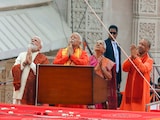- Less than eight minutes after launch, the Falcon 9 rocket returned safely to Earth
- Crew Dragon capsule carrying four astronauts, including Indian Group Captain Shubhanshu Shukla
- Launch faced six delays and a software glitch before Falcon 9 lifted off from Kennedy Space Center
Less than eight minutes after the SpaceX Falcon 9 rocket blasted off from the Kennedy Space Center in Florida, carrying a four-member crew to the International Space Station - it returned safely to Earth.
The Crew Dragon capsule containing the four astronauts, including Group Captain Shubhanshu Shukla, the second Indian to go into space, continued on its way to the ISS.
The launch, delayed six times already, hovered on the edge of a seventh delay after a software glitch prevented upload of weather data. However, that was resolved with minutes to go and, a little past 12.01 pm (India time), the Falcon 9 rocket's powerful Merlin engines roared into life.
The rocket then slowly, but surely, lifted off from the Kennedy Space Center's Launch Complex 39A - the spot from where Neil Armstrong set off for the moon on Apollo 11 in 1969.
And, with that, the Axiom Mission 4, or AX-4, was successfully launched.
What is the Falcon 9 rocket?
It is a reusable, two-stage rocket designed and manufactured by SpaceX.
It is the world's first orbital-class reusable rocket. This means SpaceX can re-use the most expensive parts of the rocket and that, in turn, drives down the cost of space missions.
It is powered by nine Merlin engines developed by SpaceX and which uses rocket-grade kerosene and liquid oxygen as propellants in a gas-generator power cycle.
Like the rocket, the engine was also designed for recovery and re-use.
The Falcon 9 has two distinct sections; it is the first that can be re-used.
This section separates from the payload, i.e., the crew capsule in this case, after successfully carrying it to a pre-set altitude and speed. At this point the booster section de-links and flies back to Earth.
SpaceX has now successfully landed the booster a staggering 451 times.
Crew Capsule
The Crew Dragon capsule is expected to reach the ISS after a flight of about 28 hours, then dock with the outpost as the two vehicles soar together in orbit some 250 miles (400 km) above Earth.
READ | Water Bears To Space Farming: India's 7 Experiments On Space Station
During the 14-day mission, Shukla and his three fellow-astronauts - from the US, Poland, and Hungary - will conduct 60 scientific experiments, seven of which have been proposed by Indian researchers.
READ | "Orbiting The Earth. Jai Hind, Jai Bharat": Shukla's Space Message
And as the capsule set off on that journey, Shukla's first words as the second Indian in space were, ""We are orbiting the Earth. This is the start of India's human space program. Jai Hind, Jai Bharat."















